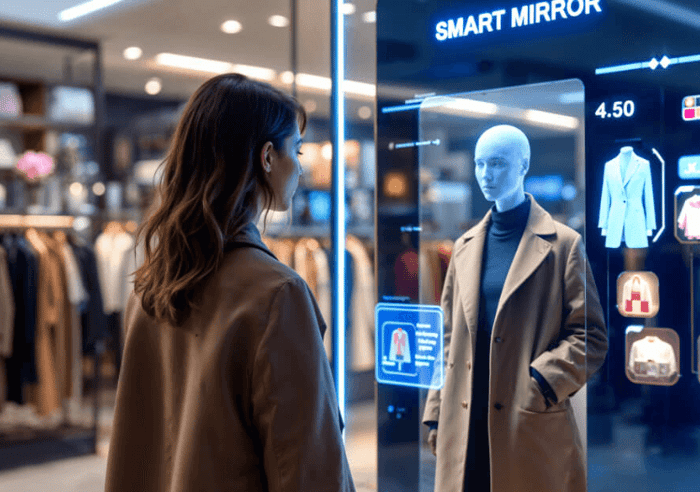The Future of AI Shopping: Smarter, Faster, Personalized
Table of Contents
- Introduction: The Rise of AI in Retail
- What Is AI Shopping and Why Does It Matter?
- Hyper-Personalization: Tailoring Every Step of the Journey
- Virtual Stylists and Smart Assistants
- Visual Search and Image-Based Discovery
- Predictive Analytics for Inventory and Trends
- AI-Generated Content and Imagery
- Conversational Commerce: Chatbots and Voice Shopping
- In-Store AI and Omnichannel Integration
- What This Means for Brands and Shoppers
- Ethical Considerations and the Human Touch
- Conclusion: The Future of Shopping Is Already Here
- FAQ: AI Shopping
Introduction: The Rise of AI in Retail
Artificial Intelligence has made its way into nearly every industry, but few have embraced it as rapidly as retail. In the age of personalization and convenience, the traditional ways of shopping are no longer enough. Enter AI shopping, a data-driven, highly personalized, and intuitive way to connect consumers with products they actually want.
With consumers expecting faster service, curated recommendations, and seamless interactions, AI has stepped in to meet those demands, revolutionizing how we discover, browse, and buy. From virtual stylists to AI-powered inventory management, the retail landscape is evolving faster than ever.

What Is AI Shopping and Why Does It Matter?
AI shopping refers to the use of artificial intelligence technologies in the retail experience to enhance efficiency, personalization, and decision-making. It touches nearly every part of the buyer journey, including:
Discovery through smart search or voice assistants
Personalization via product suggestions and tailored content
Customer service powered by chatbots and virtual shopping assistants
Post-purchase experiences like returns optimization and loyalty programs
What makes AI shopping truly transformative is its ability to learn from consumer behavior in real-time. Each click, scroll, and purchase feeds into the AI’s understanding of a shopper’s preferences, allowing the experience to improve with every interaction.
Hyper-Personalization: Tailoring Every Step of the Journey
Before AI, personalization was limited to basics like addressing emails with first names or offering discounts on past purchases. Now, AI enables:
Dynamic website content that adjusts based on browsing behavior
Real-time product recommendations based on recent activity
Personalized promotional messages via email, SMS, or in-app notifications
This level of personalization helps increase user engagement, average order value, and customer retention. For example, platforms like Amazon use AI to offer real-time “Frequently Bought Together” bundles and predictive restocking suggestions based on prior buying patterns.
Virtual Stylists and Smart Assistants
AI-powered virtual stylists have become key players in fashion e-commerce. By analyzing a user’s body shape, past purchases, and style preferences, they offer curated looks and wardrobe suggestions that match the shopper’s aesthetic.
Features of a virtual stylist:
Interactive quizzes to identify style profiles
Outfit generation based on occasion or season
AI models that simulate how clothing fits on different body types
Tools like Vue.ai, Stitch Fix, and Zalando’s Zircle platform are leveraging AI stylists to help reduce returns and improve shopping satisfaction. These smart assistants work across multiple touchpoints, from mobile apps to smart mirrors in physical stores.

Visual Search and Image-Based Discovery
Sometimes, it’s hard to describe exactly what you’re looking for. AI visual search solves this by allowing users to upload a photo and receive visually similar product results instantly.
How it works:
A user uploads an image (e.g., a dress seen on Instagram)
AI analyzes patterns, colors, textures, and shapes
The system matches it to inventory in the retailer’s database
This feature is especially valuable for fashion and home decor, where aesthetic appeal is subjective and difficult to put into words. Pinterest Lens and Google Lens are leading this space, while retailers like ASOS and Forever 21 have integrated similar features into their mobile apps.
Predictive Analytics for Inventory and Trends
One of the biggest challenges in retail is knowing what to stock and when. Overproduction leads to markdowns, while underproduction means missed sales. AI solves this with predictive analytics.
What AI can predict:
Which items will trend in the coming season
How local weather impacts purchasing habits
Which products are likely to be returned and why
By analyzing data from sources like social media, past sales, and macroeconomic trends, AI gives brands the insight needed to stay ahead—while reducing waste and improving profit margins.
AI-Generated Content and Imagery
Content is king, but creating it at scale is expensive. That’s where AI-generated imagery and copy come in.
Use cases:
AI-generated model photos in different settings or demographics
Auto-generated product descriptions tailored to different customer segments
Personalized styling guides using customer preferences
Platforms like Modelia and Botika allow brands to create entire lookbooks with AI-generated models wearing virtual versions of real products. This drastically reduces photoshoot costs and allows for faster catalog creation.

Conversational Commerce: Chatbots and Voice Shopping
Shopping is becoming increasingly conversational. Whether through voice assistants like Alexa or chatbots on a website, users are looking for faster, hands-free ways to browse and buy.
Voice shopping enables:
Reordering items with a simple phrase
Getting personalized recommendations by voice
Adding items to cart during multitasking moments
Chatbots also enhance the experience by answering FAQs, offering real-time recommendations, and helping users navigate the site, all without needing a human agent.

In-Store AI and Omnichannel Integration
AI isn’t just for online. Physical retail is also being transformed:
Smart mirrors let shoppers try on clothing virtually
Heat mapping tracks store traffic to optimize layouts
RFID and AI help automate checkout and inventory control
This blend of digital and physical, known as phygital retail, creates a more cohesive and convenient experience. AI helps unify customer data across all touchpoints, ensuring consistent recommendations whether you shop online or in-store.
What This Means for Brands and Shoppers
The impact of AI shopping is profound, and growing.
For Brands:
Data becomes the new competitive edge
Customer experience is the key differentiator
Operations become leaner, faster, and smarter
Brands that fail to invest in AI risk falling behind as competitors offer faster, more personalized experiences. On the flip side, those that adopt AI benefit from better forecasting, reduced costs, and higher customer satisfaction.
For Shoppers:
Fewer irrelevant recommendations
Faster paths to discovery
More interactive, engaging shopping experiences
In essence, AI removes friction, making shopping more intuitive, relevant, and fun.
Ethical Considerations and the Human Touch
As with any tech, AI in shopping brings ethical challenges:
Bias in algorithms: If training data lacks diversity, so will recommendations.
Data privacy: Consumers must understand how their data is used.
Over-personalization: Constant targeting can feel invasive.
Retailers must balance automation with human oversight. While AI excels at scale and speed, human designers, stylists, and merchandisers still play a crucial role in storytelling and emotional connection.
Conclusion: The Future of Shopping Is Already Here
AI shopping is no longer experimental, it’s essential. From discovering products via image search to receiving a complete outfit suggestion from a virtual stylist, consumers are increasingly expecting intelligent, responsive, and personalized experiences.
Brands that understand and embrace this shift will thrive. Those that don’t may struggle to stay relevant.Are you ready to upgrade your e-commerce experience? Explore how Modelia can power your AI retail strategy.
FAQ: AI Shopping
What is AI shopping and how does it work?
AI shopping uses artificial intelligence to personalize the shopping experience. It can recommend products based on past purchases, browsing behavior, or style preferences, helping users find items faster and more efficiently.
How does AI shopping improve the customer experience?
AI shopping provides tailored recommendations, virtual try-ons, and automated support. This makes shopping more convenient, reduces decision fatigue, and helps users discover products they might not have found otherwise.
Can AI shopping be used for fashion e-commerce?
Yes, many fashion retailers use AI shopping tools to suggest outfits, predict sizing, and personalize marketing. It enhances the online shopping journey and increases the likelihood of purchase.
Is AI shopping safe and secure?
AI shopping platforms follow data protection regulations and use encryption to keep personal information safe. Users can enjoy personalized recommendations without compromising privacy when platforms implement best security practices.
How would you rate this article:
Related Articles
- Content Marketing for Ecommerce: How to Attract and Retain Customers
- Top AI Photo Description Generator Tools for Online Sellers
- Product Photography for Ecommerce: Tips for High-Converting Images
- Smart Clothing Technology: The Future of Wearable Tech and Fashion Innovation
- Top AI Modeling Tools Transforming Fashion Design
- How to Sell Fashion on Instagram: Tips for Building Your Fashion Brand
- Best AI Tools for Apparel and Fashion Brands in 2025
- 8 AI Changes that are Revolutionizing the Fashion Industry
- Modelia Yearbook 2025: AI, Fashion and the Vision Shaping 2026
- Virtual Try-On Technology in Fashion: The Future of Online Shopping


